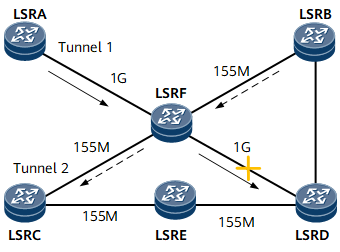Priorities and Preemption
Priorities and preemption are used to allow TE tunnels to be established preferentially to transmit important services, preventing resource competition during tunnel establishment.
- Hard preemption: A CR-LSP with a higher priority can directly delete preempted resources assigned to a CR-LSP with a lower priority. Some traffic is dropped on the CR-LSP with a lower priority during the hard preemption process. The CR-LSP with a lower priority is immediately deleted after its resources are preempted.
- Soft preemption: A CR-LSP with a higher priority can directly preempt resources assigned to a CR-LSP with a lower priority, but the CR-LSP with a lower priority is not deleted immediately after its resources are preempted. During the soft preemption process, the bandwidth assigned to the CR-LSP with a lower priority gradually decreases to 0 kbit/s. Some traffic is forwarded while some may be dropped on the CR-LSP with a lower priority. The CR-LSP with a lower priority is deleted after the soft preemption timer expires.
CR-LSPs use setup and holding priorities to determine whether to preempt resources. Both the setup and holding priority values range from 0 to 7. The smaller the value, the higher the priority. If only the setup priority is configured, the value of the holding priority is equal to that of the setup priority. The setup priority must be lower than or equal to the holding priority for a tunnel.
The priority and preemption attributes are used in conjunction to determine resource preemption among tunnels. If multiple CR-LSPs are to be established, CR-LSPs with high priorities can be established by preempting resources. If resources (such as bandwidth) are insufficient, a CR-LSP with a higher setup priority can preempt resources of an established CR-LSP with a lower holding priority.
- Tunnel 1: established over the path LSRA → LSRF → LSRD. Its bandwidth is 155 Mbit/s, and its setup and holding priority values are 0.
- Tunnel 2: established over the path LSRB → LSRF → LSRC. Its bandwidth is 155 Mbit/s, and its setup and holding priority values are 7.
- If hard preemption is used, since Tunnel 1 has a higher priority than Tunnel 2, LSRF sends an RSVP message to tear down Tunnel 2. As a result, some traffic on Tunnel 2 is dropped if Tunnel 2 is transmitting traffic.
- In soft preemption mode, Tunnel 2 is reestablished along the path LSRB → LSRD → LSRE → LSRC if LSRB does not tear down original Tunnel 2 after receiving a Resv message from LSRF. Original Tunnel 2 is torn down after traffic switchover is complete.
